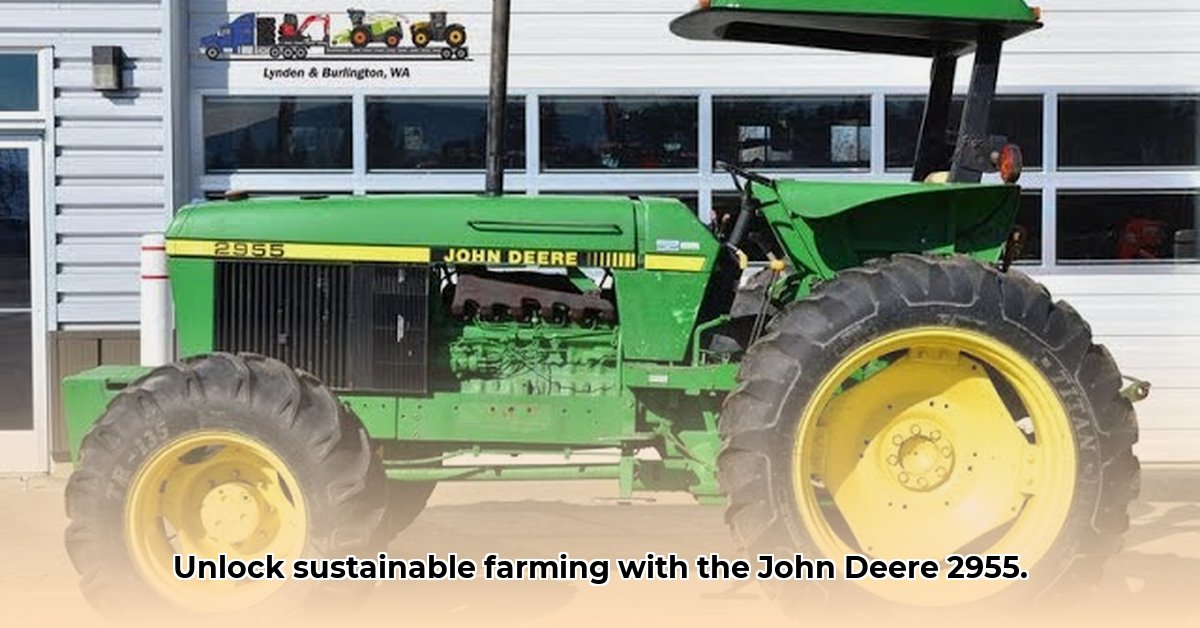
The John Deere 2955 tractor: a name synonymous with reliability and hard work. Popular in the late 1980s and early 1990s, this classic tractor continues to serve farmers worldwide. But how does this stalwart machine align with contemporary sustainable agriculture practices? This guide explores the 2955's capabilities, potential challenges, and strategies for maximizing its efficiency and longevity in environmentally conscious farming. For more information on John Deere models, check out this helpful resource.
Understanding the John Deere 2955: A Workhorse for Modern Farms
The 2955's robust construction and versatility made it a favorite among farmers. Available in both two-wheel drive (2WD) and four-wheel drive (MFWD) configurations, it handled diverse terrains and tasks with ease. Its rear remote hydraulics and power takeoff (PTO) options further enhanced its adaptability, proving its value as a true all-around machine. Many 2955s are still operational today, a testament to their durable design and smart engineering. But how well does this robust tractor fit the needs of modern, eco-conscious farming?
Is a Used 2955 the Right Tractor for You? A Comprehensive Buyer's Guide
Purchasing a used 2955 requires careful consideration. Before committing, follow these steps to ensure you're making a sound investment:
Thorough Inspection: Engage a qualified mechanic specializing in older tractors. They'll identify potential mechanical issues (worn parts, engine compression, transmission/hydraulic function, PTO operation) often missed by an untrained eye. A pre-purchase inspection is crucial.
Maintenance History: Request complete maintenance records. Consistent servicing demonstrates responsible ownership and predicts the tractor's future reliability. Missing records should raise caution.
Test Drive: Thoroughly test the tractor under various conditions (hills, fields, different operations). Assess its responsiveness and performance to identify potential limitations or problems.
Parts Availability: Investigate local parts suppliers and online resources. Ensuring a reliable supply chain is critical for minimizing downtime and maintenance costs, especially for older models.
Sustainability Considerations: Balancing the 2955's Strengths and Weaknesses
Fuel efficiency is a key concern in modern sustainable agriculture. Compared to contemporary models, the 2955's fuel economy is relatively lower, impacting both operating costs and environmental impact. However, fuel-saving strategies can help mitigate this.
"Proper tire inflation and meticulous field management, such as minimizing passes, can significantly contribute to reduced fuel consumption and lower operating costs," says Dr. Emily Carter, Agricultural Engineer, University of California, Davis.
The 2955's durability counteracts its lower fuel efficiency. A well-maintained 2955 can have a remarkably long operational life, reducing the need for frequent replacements – a significant sustainability factor. This extended lifespan contributes to minimizing the overall environmental impact.
The 2955 in Sustainable Farming: A Balanced Perspective
The John Deere 2955 offers a unique position in sustainable agriculture. It presents a balance of advantages and drawbacks:
| Advantages | Disadvantages |
|---|---|
| Rugged construction and reliable performance | Lower fuel efficiency compared to modern tractors |
| Versatility for various farm operations | Parts may be more difficult to source |
| Potentially lower initial purchase cost | Higher potential for maintenance costs |
| Extended lifespan reduces long-term costs | May not meet the sustainability standards of newer models |
Maximizing the 2955's Lifespan and Fuel Efficiency: A Practical Guide
The following strategies are crucial for extending the operational life of your 2955 and improving its fuel efficiency:
Preventive Maintenance: The Cornerstone of Efficiency
Proactive maintenance is key. Neglecting maintenance leads to increased wear, reduced performance, and higher fuel consumption.
- Regular Oil Changes: Follow manufacturer-recommended oil change intervals. Old oil increases friction and fuel consumption.
- Air Filter Maintenance: Clean or replace clogged air filters regularly. Restricted airflow forces the engine to work harder, consuming more fuel.
- Cooling System Inspection: Ensure the cooling system functions correctly. Overheating damages the engine and drastically increases fuel consumption.
- Transmission Fluid Checks: Regular inspection and changes of transmission fluid are crucial for smooth operation and efficiency.
Operational Techniques for Fuel Savings
Your operating practices significantly impact fuel consumption:
- Proper Tire Inflation: Maintain correct tire pressure to reduce rolling resistance.
- Load Management: Avoid overloading the tractor. Overloading puts extra strain on the engine and increases fuel consumption.
- Attachment Selection: Choose attachments appropriate for the task. Using heavier attachments than necessary wastes fuel.
- Minimize Idling: Reduce idling time; idling burns fuel without productive work.
Addressing Hydraulic System Limitations
The 2955's hydraulic system can be a source of inefficiency. Consider these options:
- Ported Filter Cover: Installing a ported filter cover return kit can help manage hydraulic heat, reducing engine strain and improving fuel efficiency.
- High-Flow Attachment Use: Limit the use of high-flow attachments, as these can lead to hydraulic overheating and increased fuel consumption. Smaller tasks are better suited to the 2955.
Long-Term Strategies
Plan for long-term maintenance and potential upgrades:
- Transmission Overhaul: Budget for eventual transmission overhaul; this is a significant cost but necessary for maintaining efficiency.
- Engine Upgrades (if feasible): Research potential engine upgrades (if available and cost-effective) to enhance fuel efficiency. This should be explored carefully.
By following these strategies, you can significantly extend the lifespan of your John Deere 2955 and improve its fuel efficiency, making it a valuable and sustainable asset for your farm for many years to come.